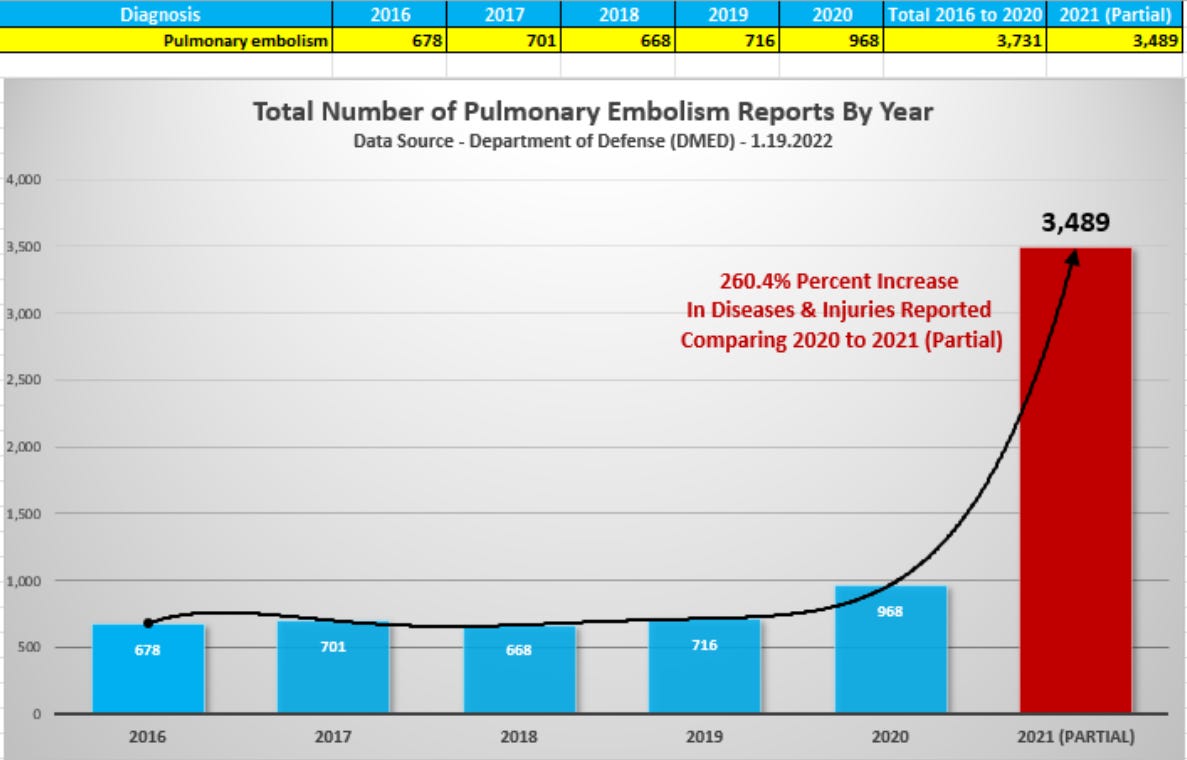Update: DoD has 'updated' the numbers in the DMED
The changes to the numbers are baffling and don't pass the smell test
Just a couple of days ago, I described the report from three DoD (Department of Defense) whistleblowers that many of the conditions & symptoms of potential COVID vaccine injuries were much higher in 2021 than in the five years before (2016-2020).
In other words - these huge increases (2-25x more!) were not seen after c19 infections rose, but only in the year when 85-96% of the military got multiple injections with the mRNA shots.
After the whistleblower’s data was made public, a military spokesman said the 2021 numbers were correct, but that the 2016-2020 numbers were, for some unexplained reason, not being reported in the DMED (Defense Medical Epidemiology Database).
Well, the ‘corrections’ are in.
And they are baffling.
The full spreadsheet, both ‘before’ and ‘after’ can be downloaded here.
I will only present one or two examples here, for a much more in-depth (and longer) analysis, go read Steve Kirsh’s substack.
Using data supplied by the military, here are the “before correction” and “after correction” graphs for total active-duty military hospitalizations.
“Before” (below) shows a nearly 37% increase in hospitalization in 2021 (partial, because it does not include the last couple of months of data), strongly implicating the mRNA shots.
“After” the DoD corrections (below), you can see that the numbers for 2021 are unchanged, but the number of hospitalizations in 2016-2020 have been increased by about 50% per year. Each.
These ‘corrected’ numbers results in 2021 now reporting 13% fewer hospitalizations than the previous 5 years.
Wow, that was quite a glitch!
Without commenting on the ‘strangeness’ of the data alterations (but see below!), this ‘new’ data raises at least one important question:
Why would the number of people going to the hospital decrease notably in the middle of the worst pandemic in 100 years????
My opinion is that the DoD data changes are suspicious, to say the least.
Just one example - pulmonary embolisms.
A pulmonary embolism (PE) is a blood clot that lodges in the arteries of the lungs. It can be an extremely dangerous condition - in fact, it is the third leading cause of death in the US.
Like many diseases, PE is much more common in the elderly. So, while the overall rate of PE in the USA is estimated to be 69 per 100,000 people, the rate among the young and healthy (like active-duty military personnel) is much lower.
The rate of PE for military-age people should be much lower, around 10-50 per 100k (same source, Table 2).
This is the incidents of PE in the DMED as reported by the whistleblowers (‘before corrections’).
A 260% increase!
Now… ‘after corrections’:
Again, notice that the number of PE reports for 2021 stays the same, but PE incidents for 2106-2020 are much, much higher than before.
And again… quite a correction!
But lets look at those numbers more closely.
There are approximately 1.4 million active duty personnel.
If we use the (much too high) estimate of PE for all age groups of 69 per 100,000 people, we would expect to see about 966 cases of PE in the military.1
This is right in line with the “before correction” data that shows between 668 - 716 cases each year (even the slight rise in 2020 is logical, as PE is a known consequence of severe COVID infection).
But the “after correction” data is not in line. It is not even in the ballpark.
The lowest number of PE reports from 2016-2020 is now 2,591.
That is an annual (‘corrected’) rate of over 185 per 100k!!!
Are we to believe that this ‘corrupted’ data system gave completely reasonable results WHILE it was corrupted, but the ‘correct’ version gives results that are 3 - 18x times higher than should be expected???
The government ‘corrections’ do not pass the smell test.
If the coverup is this bad, perhaps the wheels are about to come off….
(69 PE cases/100,000 people) x 1,400,000 people = 966 cases
2,591 cases x 1,400,000 people /100,000 = 185.97 cases/100,000 people







Prior to adjustment, the DMED data aligned very well by condition with VAERS, Ronald Kostoff's analysis in Toxicology Reports, and data from New Zealand during a time period when vaccines were available while the entire country had essentially no SARS-CoV2 cases https://www.youtube.com/watch?v=VVxmAIKjYM4 I can't imagine that this effort to change the data (which as you have astutely observed shows incredible increases above the base rate for these rare conditions in the active duty population) is the product of a legitimate effort to address the situation by the DHA. If it were, I would expect that they would want to show us some p-values for how likely it is for these rates to be so inflated over the norm for the past 5 years (probably something like p < .001 or worse) then come up with some hypotheses for how the hell that's possible. At this point I think you would have to be hopelessly naive to not just assume the intent of manipulating the data is to serve a political agenda (as opposed to improve the accuracy of the data within DMED). Thanks for your coverage of this important issue!
Here is how you prove DoD manipulated the data. Focus on annual HIV infections. The infection rate for HIV (all years) for service members is about 20 cases per 100,000 according to https://sgp.fas.org/crs/natsec/IF11238.pdf (page 7-5700). That data goes up to 2017 but you can see a 20 year trend with not much variance. Then in 2021 we see in the DMED data a jump of over 400% in new HIV infections (DMED 5 year average is 454 up to 2273 in the year 2021). Ask DoD for the revised HIV numbers for all years and see what you get. HIV is the key here in proving data manipulation.
This is how to calculate military HIV infections per capita with the 2021 spike. The number of annual new infections among all service members has been about 20 per 100,000 (2000 - 2020) out of 2.1 million service members (includes active and reserve from all branches) is about 420. In 2019 DMED reported 415 new HIV infections. If new infections in 2021 are 2273 then the military HIV infection rate has soared to 108 per 100,000.